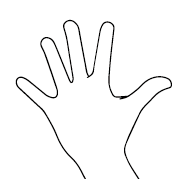TSL | Taiwan Sing Language Gleaning
Vertical Timeline in TSL
TSL uses two timelines, one vertical, one horizontal. Parallel with the body, the vertical timeline is used to indicate era (e.g. last generation, dynasty, history), family relations (father, mother, grandchildren, brothers, and sisters), and positions in organizational and social hierarchy (manager, employer, teacher). Signs held higher than the body represent someone with higher position or family seniority than the signer; Signs held lower than the body represent someone with lower position or family seniority than the signer. The farther away the sign is held (either higher or lower) from the body, the larger the difference is in age or seniority. For example, the sign for father essentially means a man one generation older than I. It is held upwards in a small curve to indicate one level higher. Following the same logic, the sign for grandfather is held upwards twice, meaning two levels higher. If the motion is repeated multiple times, it means ancestor.Different from horizontal timeline, the vertical timeline is not used to indicate direct temporal relationships. For example, last year is rarely expressed as a year higher than this year in a vertical timeline. Rather, the vertical timeline is used to indicate former/last one. E.g. former head of state, last sport game. The vertical timeline thus stresses the order in which the events take place. In TSL, signs that are held higher refer to individuals of higher positions, a reflection of a universal human tendency to express hierarchical positions or social status in terms of vertical levels, namely high and low.
Example sentence
- We usually do Tai Chi together. If one of us doesn't feel well, the other two will take him to see a doctor. We are close like real brothers. Lao Wang is the oldest, Lao Li is the second oldest and I am the youngest.
- Both of our families have lived in Baihe for a long time. We were born and grew up here.










































































































